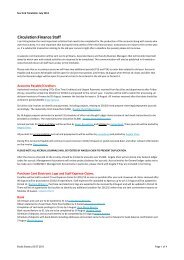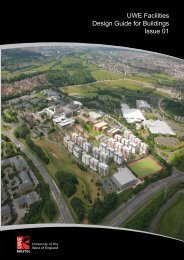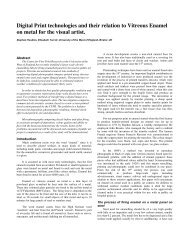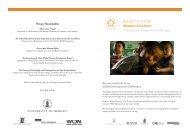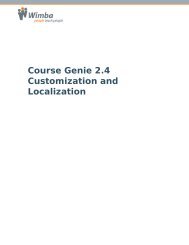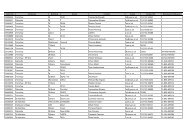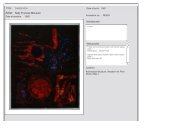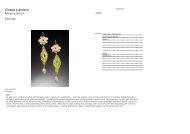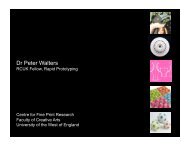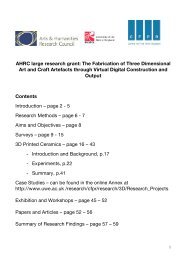Materials and Process Innovation for 3D Printing of Ceramics David ...
Materials and Process Innovation for 3D Printing of Ceramics David ...
Materials and Process Innovation for 3D Printing of Ceramics David ...
You also want an ePaper? Increase the reach of your titles
YUMPU automatically turns print PDFs into web optimized ePapers that Google loves.
Centre <strong>for</strong> Fine Print Research: <strong>3D</strong> Laboratory<strong>Materials</strong> <strong>and</strong> <strong>Process</strong> <strong>Innovation</strong><strong>for</strong> <strong>3D</strong> <strong>Printing</strong> <strong>of</strong> <strong>Ceramics</strong><strong>David</strong> Huson Research Fellow Centre <strong>for</strong> Fine Print Research University <strong>of</strong> the West <strong>of</strong> Engl<strong>and</strong>
Areas <strong>of</strong> investigation • The use <strong>of</strong> <strong>3D</strong> printing technologies <strong>and</strong> CNC machiningto translate a computer <strong>3D</strong> model into a mould capable<strong>of</strong> producing a bespoke ceramic artefact• The use <strong>of</strong> laser scanning, reverse engineering <strong>and</strong>digital fabrication techniques to facilitate the production<strong>of</strong> short runs <strong>of</strong> bespoke ceramic artefact• To research the possibilities, <strong>and</strong> then develop themethodology <strong>of</strong> <strong>for</strong>ming a bespoke ceramic artefactdirectly by the use <strong>of</strong> <strong>3D</strong> printing <strong>and</strong> other RPtechnologies
<strong>3D</strong> laser scanning
Z-‐Corp Powder-‐Binder <strong>3D</strong> Prin8ng System Roller Print Head Feed Piston Build Piston Feed Drive Build Drive
Z Corp 310 Printer
<strong>3D</strong> printed artworks
<strong>3D</strong> printing <strong>of</strong> ceramic artworks• The <strong>3D</strong> computer model is drawn in a CAD program orgenerated from data collected by a <strong>3D</strong> scanner (or acombination <strong>of</strong> the two)• The proprietary material in a Z Corp <strong>3D</strong> printer isreplaced with a ceramic body powder• <strong>3D</strong> printing <strong>of</strong> ceramics allows an artist to move directlyfrom the <strong>3D</strong> model to a finished article without usingtraditional modelling <strong>and</strong> mould making processes
<strong>3D</strong> printed ceramic test pieces
CAD model <strong>of</strong> ‘impossible’ ceramic object
<strong>Printing</strong> object in ceramic powder
Post-processing printed ceramic
<strong>3D</strong> printed ceramics
Spray dried ceramic body • Advantage• Disadvantage– Easily available– Prepared body– Correct thermalexpansion – Coarse grain size– Poor green strength– Needs pre-sintering topost process
<strong>3D</strong> ceramic printing with ball clay
<strong>3D</strong> ceramic printing with ball clay • Problems– Layers curling duringprinting– Layers movingduring printing– Cracking <strong>and</strong>distortion
<strong>3D</strong> ceramic printing with ball clay • Advantage– Easily available– Fine particle size– Better green strengthso no pre-sinteringrequired• Disadvantage– High plasticity– Low thermalexpansion– Difficult to fit glaze
Earthenware type ceramic body• Dry blended from powder constituents– ball clay– china clay– silica filler– flux• Binder additives to improve green strength• Adjust orientation in build bed to reduce layer shift
Printed examples
Fired examples
Earthenware type ceramic body • Far better but still some problems– Layer shift– Variable surface quality– High porosity– High fired contraction
Layer shift
Dead swallows
Dead swallows
Dead swallows
To improve the process • Investigate particle size distribution• Increase green strength <strong>of</strong> body• Reduce binder saturation• Reduce porosity <strong>and</strong> contraction• Have ability to use wider range <strong>of</strong> ceramic bodies• Decided to develop a process to adapt commerciallyavailable ceramic bodies <strong>for</strong> use with the Z Corp <strong>3D</strong>printers
New body characteristics • Ball milling <strong>of</strong> body toimprove particle sizedistribution• Improved binder in bodymix to increase greenstrength• Reduced bindersaturation to eliminatelayer shifting• Adjust the body mix toreduce fired contraction
Firing contraction <strong>and</strong> porosity
Manta
<strong>3D</strong> printed in bone china
Removing from bed
Fired with setter
With coloured 3d prints
Trumpet sphere cad model
Urchin cad model
Trumpet sphere <strong>3D</strong> printed
Urchin <strong>3D</strong> printed
<strong>3D</strong> printed ceramic
Further developments • Need to reduce the porosity <strong>and</strong> fired shrinkage• Need to improve the green strength• Need to improve printing per<strong>for</strong>mance <strong>and</strong> eliminatelayer shift• To achieve these aims it was decided to develop anew type <strong>of</strong> ceramic body <strong>and</strong> process methodologythat would work specifically with the characteristics <strong>of</strong>the Z Corp <strong>3D</strong> printing system
Future Developments• Exhibition <strong>of</strong> <strong>3D</strong> printedceramic artworks• Patent application• License agreement with ZCorp.




